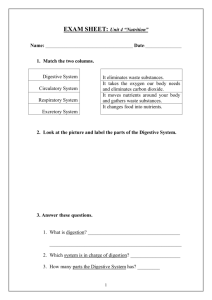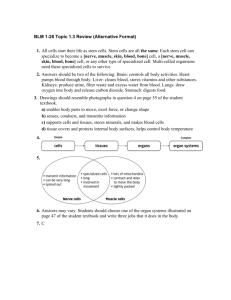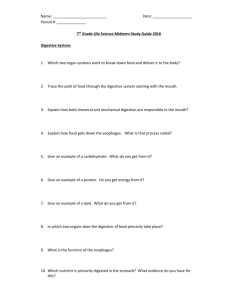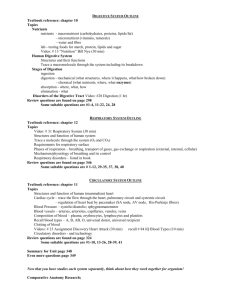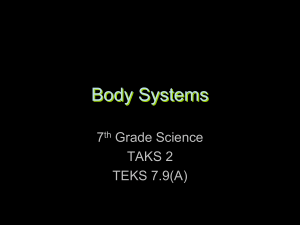2-16-16
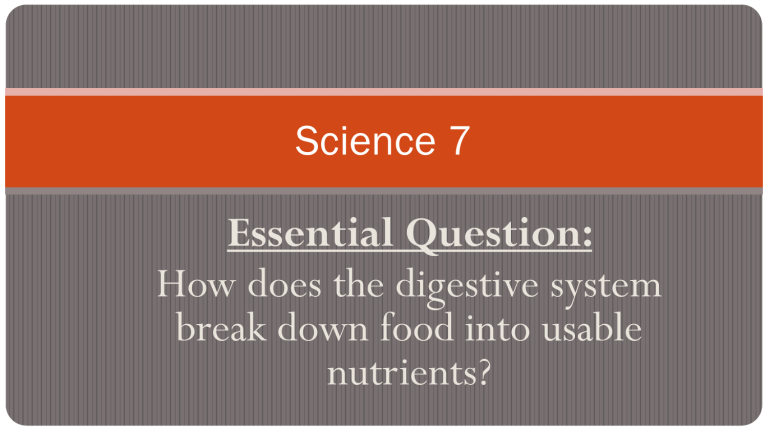
Science 7
Essential Question:
How does the digestive system break down food into usable nutrients?
Next Science Test:
“Human Body Systems” Unit Test
• Date changed to the week of
February 29
• Study guide is also posted online
Homework: Science
I recommend that you complete SLIDE 11 from this unit’s review slides if they have not been completed yet
DUE DATE FOR REVIEW SLIDES:
FRIDAY, FEBRUARY 26
Body Systems:
This system of the body provides structure and support for the body; it also allows for movement
SKELETAL SYSTEM
This part of the skeleton protects internal organs and includes the ribcage, spine, and skull
AXIAL SKELETON
This part of the skeleton allows for movement
APPENDICULAR SKELETON
This body system is composed of tissues that contract and relax and is what causes bones to move
MUSCULAR SYSTEM
Muscular System: Muscles
These are tissues that contract (shorten) and relax (get longer) in order to PULL THE BONES in a direction. They work in pairs; when one muscle in a pair contracts, the other muscle in the pair relaxes.
SKELETAL MUSCLES
These are tissues that connect muscles to bones.
TENDONS
These are tissues that connect bones to bones. They are always found at movable joints
LIGAMENTS
Respiratory System: Vocabulary
This organ system plays the important role in the body of absorbing oxygen into the body from air and releasing carbon dioxide from the body into the air.
RESPIRATORY SYSTEM
These organs absorb oxygen into the blood and release carbon dioxide from the blood
LUNGS
This organ connects the mouth and nasal cavity to the lungs; also know as the windpipe
TRACHEA
Circulatory System: Vocabulary
This organ system transports oxygen and nutrients to the cells of the body, and carries away carbon dioxide and waste from the cells
CIRCULATORY SYSTEM
This organ is the pump that keeps all of the blood flowing through the circulatory system
HEART
These cells give blood their color and carry oxygen to the cells
RED BLOOD CELLS
These are far fewer than red blood cells and fight pathogens (germs) that enter the body
WHITE BLOOD CELLS
Circulatory System: Vocabulary
These are blood vessels that pump oxygen-rich blood to your cells; they are shown in red on a diagram
ARTERIES
These are blood vessels the pump carbon dioxide-rich blood to your lungs; they are shown in blue on a diagram
VEINS
These cells cause blood to clot and stop bleeding when there is a cut
PLATELETS
Today’s Topic:
How does the digestive system break down food into usable nutrients?
Digestive System: Vocabulary
This system of the body, made up of many many different organs, turns food into usable nutrients that the body can use for its processes.
DIGESTIVE SYSTEM
Digestive System: Vocabulary
These are materials that living things need in order to build, repair, and maintain their body functions. Examples include proteins, fats, sugars, and water.
NUTRIENTS
Warm-up: Discuss with Your Groups
How does your body break down food into the nutrients it needs?
Brainstorm!
Digestive System: Notes
Your Digestive System breaks down food in two ways:
MECHANICAL DIGESTION- the digestive system crushes and rips apart the food into smaller pieces (PHYSICAL CHANGE)
CHEMICAL DIGESTION- the digestive system uses chemicals to break apart the chemical bonds holding food together, converting it into usable nutrients (CHEMICAL CHANGE)
Yellow Textbook: pages B45-B48
Read through this section with your groups. In your notebooks, I want you to find and record:
Three examples of MECHANICAL DIGESTION.
Describe where they happen in the digestive system
Three examples of CHEMICAL DIGESTION. Describe where they happen in the digestive system
Exit Ticket:
Login to SCHOOLNET
Type in the below passcode:
DY2GY3QU5



